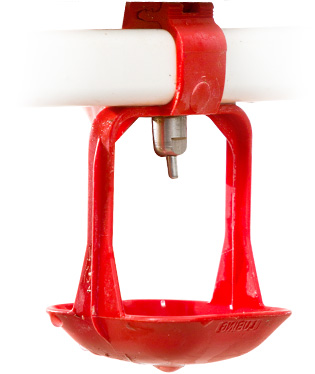

Treatment Methods
Poultry red mites are difficult to control as they can be transferred between flocks by shipping crates, clothing and wild birds. Current methods for managing red mites lack sufficient efficacy to keep infestations under control in many poultry farms.1
Chemical control is a common treatment method, which involves spraying the local environment including walls, floors, roosts, nest boxes and birds. However, these treatments have many complications including:
- Short residual activity2
- Inability to reach cracks and crevices where mite colonies are located
- Little or no effect on mite eggs, thus enabling regrowth of infestation burdens
- Risk of feed contamination
- High costs of labor and worker protection equipment
- Egg and meat withdrawal periods following treatment
- Mite resistance development3
Because of the many problems associated with use of conventional chemicals and pesticides for controlling poultry red mites, several new alternative solutions have been proposed or developed in recent years, including essential oils, biological compounds, predator mites, heat treatments, intermittent lighting programs, inert dusts and even vaccines.1

The financial impact of red mites.
In addition to physiological harm to birds, poultry red mites damage the
productivity of birds and operations with annual industry losses in the millions.
Breakthrough Solution
Now available to the market in many countries is an innovative parasiticide for chickens which provides potent efficacy against poultry red mites. It is administered in the drinking water to provide fast, convenient and potent efficacy, with proven safety for chickens and the users of the product.
Following the recommended treatment regimen of two doses in the drinking water, seven days apart, near-total elimination of mite populations in the treated houses can be quickly achieved in all layer, breeder and/or pullet houses. In fact, the dosage regimen spans two mite life cycles – killing mites with more than 99 percent efficacy.
When used in conjunction with proper biosecurity measures, the treatment program fights mite resistance and contributes toward long-term treatment of mite populations in poultry houses.
To discover breakthrough mite control, contact your veterinarian.

1 Mozafar F, Tierzucht L. Tackling red mite in laying hens remains a challenge. World Poultry – Health. Jul 2, 2014.
http://www.worldpoultry.net/Health/Articles/2014/7/Tackling-red-mite-in-laying-hens-remains-a-challenge-1438417W/
2 Mul M. Validation of an automated mite counter for Dermanyssus gallinae in experimental laying hen cages. Exp Appl Acarol 2015; 66:589-603.
3 Abbas RZ, Colwell DD, Iqbal Z, Khan A. Acaricidal drug resistance in poultry red mite (Dermanyssus gallinae) and approaches to its management. World’s Poultry Sci J 2014; 70:113-124.

Contact Us
Through this form, submit your questions about red mites to the Technical Team in your local MSD Animal
Health region. For more immediate questions, contact your veterinarian.
